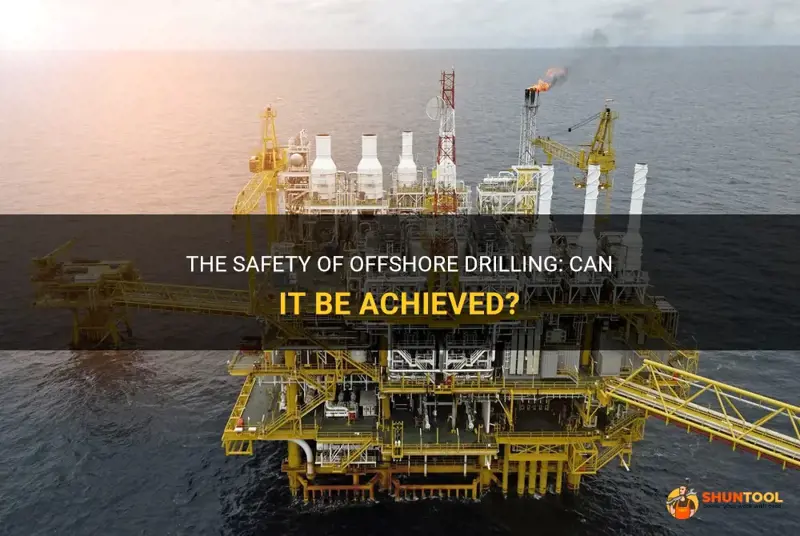
Offshore drilling has long been a controversial topic, with environmentalists raising concerns about the potential negative impacts it can have on marine ecosystems. However, in recent years, advancements in technology and stricter regulations have led to increased efforts to ensure that offshore drilling can be conducted safely. While there are still risks associated with this industry, proponents argue that with proper precautions and monitoring, offshore drilling can coexist with the environment and provide valuable resources for our energy needs. But can offshore drilling truly be safe, or are the risks too great to justify the benefits? In this article, we will explore the various factors at play and delve into the question of whether offshore drilling can be conducted in a way that minimizes harm to the environment and ensures the safety of all involved.
| Characteristics | Values |
|---|---|
| Well design | Safe |
| Blowout preventer | Essential |
| Well maintenance | Critical |
| Proper training | Necessary |
| Regular inspections | Important |
| Emergency response | Crucial |
| Environmental impact | Manageable |
What You'll Learn
- What safety measures are currently in place to ensure that offshore drilling is safe?
- What are the potential risks and challenges associated with offshore drilling, and how can they be mitigated?
- Can offshore drilling be made safe enough to prevent major environmental disasters, such as oil spills?
- How do offshore drilling regulations and standards differ between countries, and which countries have the strictest safety requirements?
- Are there any new technologies or innovations being developed to improve the safety of offshore drilling operations?

What safety measures are currently in place to ensure that offshore drilling is safe?
Offshore drilling is a vital part of the global energy industry, but it also presents potential risks to the environment and worker safety. To ensure that offshore drilling is conducted safely, a number of important safety measures have been put in place.
First and foremost, all offshore drilling operations are subject to stringent regulations and standards set by regulatory bodies such as the United States Coast Guard (USCG) and the International Association of Drilling Contractors (IADC). These regulations cover a wide range of safety aspects, including equipment design and maintenance, emergency preparedness, and worker training.
One key safety measure is the use of blowout preventers (BOPs). A blowout preventer is a large valve system designed to control the flow of oil and gas in the event of an uncontrolled release. These devices are installed on the wellhead and are capable of sealing off the wellbore in an emergency. BOPs are regularly tested and inspected to ensure they are functioning properly and are ready to activate when needed.
Another critical safety measure is the implementation of well control procedures. Before drilling begins, a thorough risk assessment is conducted to identify potential hazards and develop appropriate control measures. This includes evaluating the geological conditions, assessing well pressures, and designing a drilling program that minimizes the risk of a blowout or loss of well control. Well control procedures also involve regular monitoring of wellbore pressures and maintaining strict well control practices during drilling and completion operations.
To address the potential risks associated with offshore drilling, extensive safety training is provided to all personnel involved. Rig workers undergo rigorous training programs that cover emergency response procedures, well control techniques, and the proper use of safety equipment. Additionally, drills and exercises are carried out regularly to ensure that workers are familiar with safety protocols and can respond effectively in the event of an emergency.
In terms of environmental protection, offshore drilling operations are subject to strict environmental regulations and best practices. These include measures to prevent oil spills, such as the use of double-hulled tankers and advanced leak detection systems. Additionally, operators are required to have contingency plans in place to respond to potential spills, including the availability of rapid response teams and equipment to contain and clean up oil spills.
The safety measures and protocols discussed above are continuously evolving as new technologies and best practices emerge. Industry organizations and regulatory bodies collaborate to review and update safety guidelines to ensure that offshore drilling operations are conducted as safely as possible.
In conclusion, safety is a top priority in the offshore drilling industry. Regulatory bodies, industry organizations, and operators collaborate to develop and enforce stringent safety regulations and practices. These measures include the use of blowout preventers, well control procedures, extensive safety training, and environmental protection measures. Through these measures, the industry strives to minimize the risks associated with offshore drilling and protect both workers and the environment.
Choosing the Right Drill Bit for Holes in a Wagon: A Complete Guide
You may want to see also

What are the potential risks and challenges associated with offshore drilling, and how can they be mitigated?
Offshore drilling is a crucial activity for accessing oil and gas reserves beneath the ocean floor. While it has a significant contribution to global energy production, it also comes with potential risks and challenges that need to be addressed to ensure environmental protection and worker safety. In this article, we will explore these risks and challenges and discuss strategies to mitigate them.
One of the primary concerns associated with offshore drilling is the potential for oil spills. Accidents or equipment failures can lead to the release of oil into the ocean, causing significant harm to marine ecosystems and coastal communities. To mitigate this risk, rigorous safety regulations and protocols must be in place. These should include regular equipment inspections, emergency response plans, and proper training for personnel. Additionally, the use of advanced technologies, such as blowout preventers and redundant safety systems, can help prevent and contain oil spills.
Another challenge is the impact of seismic surveys and drilling operations on marine life. The loud sounds produced during these activities can disrupt the communication, feeding, and breeding patterns of marine species, including whales and dolphins. To address this concern, strict guidelines must be followed to limit the use of seismic surveys and drilling activities during sensitive periods, such as mating seasons. Additionally, marine mammal observers can be deployed to monitor the area and halt operations if any endangered species are detected.
Furthermore, offshore drilling can contribute to water and air pollution. The discharge of drilling fluids and other waste materials into the ocean can harm marine ecosystems, while the emission of greenhouse gases during drilling operations can contribute to climate change. To minimize these impacts, operators should implement effective waste management systems, including the proper treatment and disposal of drilling fluids. Additionally, the use of cleaner technologies, such as drilling rigs powered by natural gas instead of diesel, can reduce air pollution and carbon emissions.
The offshore environment also presents unique safety challenges for workers. They are exposed to harsh weather conditions, heavy machinery, and potential accidents. To ensure their safety, strict safety protocols must be in place, including the use of personal protective equipment, regular safety training, and the presence of emergency response teams. Additionally, regular maintenance and inspections of equipment and infrastructure are essential to identify and address potential risks before they lead to accidents.
In conclusion, offshore drilling comes with potential risks and challenges that need to be properly managed. By implementing strict safety regulations, utilizing advanced technologies, following environmental guidelines, and prioritizing worker safety, the industry can mitigate these risks. Additionally, continuous research and innovation in the field can help develop cleaner and safer drilling techniques, ensuring the sustainable exploration and exploitation of offshore oil and gas reserves.
Understanding the Reasons Behind a Makita Cordless Drill Battery Not Charging
You may want to see also

Can offshore drilling be made safe enough to prevent major environmental disasters, such as oil spills?
Offshore drilling for oil and gas is a complex and high-risk activity that has the potential to cause significant environmental damage if not managed properly. However, with advancements in technology and improved safety regulations, it is possible to minimize the risk and prevent major disasters such as oil spills.
One of the key factors in ensuring the safety of offshore drilling is the use of advanced drilling techniques and equipment. Over the years, there have been significant technological advancements in the drilling industry, including the use of blowout preventers (BOPs) and advanced drilling tools. For example, modern BOPs are designed to automatically seal the well in the event of a blowout, preventing the release of oil or gas into the surrounding environment. Additionally, new seismic imaging techniques allow for better estimation of reservoir conditions, reducing the risk of unexpected pressure surges during drilling operations.
Strict regulations and safety standards also play a crucial role in preventing environmental disasters. Governments around the world have implemented a range of regulations to ensure the safety of offshore drilling operations, including requirements for regular inspections, emergency response plans, and well control measures. These regulations are continuously updated and improved based on lessons learned from past incidents.
Furthermore, industry and government collaboration is essential in preventing major disasters. Companies operating in the offshore drilling industry must adhere to strict safety protocols and undergo regular audits to ensure compliance. Governments also play a vital role in overseeing drilling operations and enforcing safety regulations. Regular inspections and audits help identify potential risks and ensure that all necessary safety measures are in place.
The use of redundant safety systems is another important strategy to prevent major environmental disasters. Redundant systems, such as backup drilling control systems and multiple barriers in well design, provide an additional layer of protection in case of equipment failure or human error. These redundant systems help contain any potential spills or releases, preventing them from spreading further into the environment.
In recent years, the industry has also made significant progress in addressing the environmental impact of offshore drilling. Improved oil spill response technologies, such as the use of dispersants and skimmers, have been developed to effectively respond to and mitigate the effects of spills. Additionally, efforts are being made to reduce the overall environmental footprint of offshore drilling through the use of environmentally friendly drilling fluids and improved waste management practices.
While it is impossible to completely eliminate the risk of offshore drilling, the combination of advanced technology, strict regulations, industry collaboration, and environmental stewardship can greatly reduce the likelihood and impact of major environmental disasters. However, it is crucial to remain vigilant and continuously improve safety standards and practices to ensure the long-term sustainability of offshore drilling operations. By investing in research and development, implementing robust safety measures, and fostering a culture of environmental responsibility, offshore drilling can be made safe enough to prevent major environmental disasters such as oil spills.
The Cost of Drilling a Well in Tonopah, Arizona: What You Should Know
You may want to see also

How do offshore drilling regulations and standards differ between countries, and which countries have the strictest safety requirements?
Offshore drilling is a crucial aspect of global energy production, but it also poses significant risks to the environment and workers' safety. To mitigate these risks, countries around the world have implemented regulations and standards to ensure the safe and responsible operation of offshore drilling activities. However, these regulations and standards can vary significantly between countries, with some nations having stricter requirements than others. In this article, we will explore how offshore drilling regulations and standards differ between countries and identify which countries have the strictest safety requirements.
One key factor that influences offshore drilling regulations is the level of oil and gas activity in a particular region. Countries with extensive offshore drilling operations tend to have more robust regulations in place to protect their environment and ensure the safety of their workers. For example, the United States, which has a long history of offshore drilling in the Gulf of Mexico and other coastal regions, has some of the strictest regulatory frameworks in the world.
In the United States, offshore drilling is regulated by multiple agencies, including the Bureau of Safety and Environmental Enforcement (BSEE) and the U.S. Coast Guard. These agencies impose stringent requirements on drilling companies, such as conducting thorough environmental impact assessments, implementing effective safety measures, and maintaining proper well control equipment. Additionally, the U.S. government conducts regular inspections and audits to monitor compliance with these regulations.
Other countries with significant offshore drilling activities, such as Norway and the United Kingdom, also have well-established regulatory frameworks. Norway's Petroleum Safety Authority (PSA) oversees offshore drilling operations and maintains strict safety requirements, including comprehensive risk assessments, emergency preparedness plans, and regular safety inspections. Similarly, the United Kingdom's Health and Safety Executive (HSE) regulates offshore drilling activities and enforces stringent safety standards, including well control measures and blowout prevention systems.
In contrast, some countries with less offshore drilling activity may have relatively less stringent regulations. For example, countries in Latin America and Africa, which are still developing their offshore oil and gas industries, may not have as comprehensive regulatory frameworks as more established players. However, as these regions increasingly explore and exploit their offshore resources, they are recognizing the need for stricter regulations to protect their environment and ensure worker safety.
It is important to note that stricter regulations do not necessarily guarantee better safety outcomes. While some countries may have more stringent requirements on paper, it does not guarantee full compliance or effective implementation in practice. Ultimately, the overall safety performance of offshore drilling activities depends on various factors, including the culture of safety within the industry, the competency of operators, and the effectiveness of regulatory oversight.
In conclusion, offshore drilling regulations and standards can vary significantly between countries, with some nations having stricter safety requirements than others. Countries with extensive offshore drilling activities, such as the United States, Norway, and the United Kingdom, have well-established regulatory frameworks to ensure the safe and responsible operation of these activities. However, as the global offshore oil and gas industry continues to expand, other countries are recognizing the need for stricter regulations to protect the environment and worker safety. Ultimately, the effectiveness of these regulations depends on various factors beyond the regulations themselves, highlighting the importance of a comprehensive and multi-faceted approach to offshore drilling safety.
Can Metal Epoxy Hold Up to Drilling and Tapping?
You may want to see also

Are there any new technologies or innovations being developed to improve the safety of offshore drilling operations?
Offshore drilling operations have always been a high-risk industry due to the challenging and unpredictable nature of the marine environment. However, with the advancement of technology, there has been a continuous effort to improve the safety of these operations. Many new technologies and innovations are being developed to minimize the risks associated with offshore drilling.
One such technology is the use of autonomous underwater vehicles (AUVs) for inspection and maintenance of drilling equipment. These AUVs are equipped with advanced sensors and cameras that can detect any faults or damage to the equipment. They can also be programmed to perform routine inspections and maintenance tasks, reducing the need for human intervention in hazardous environments.
Another innovation that has greatly improved safety in offshore drilling is the development of blowout preventers (BOPs). A blowout preventer is a large valve that is installed at the wellhead to control the flow of oil or gas in the event of a blowout. Modern BOPs are equipped with multiple redundant systems to ensure their reliability. They are also designed to withstand extreme pressures and temperatures, providing an additional layer of protection.
In recent years, there has been a growing trend towards the use of remote monitoring and control systems in offshore drilling operations. These systems allow operators to monitor the drilling process from a centralized control room onshore. They provide real-time data on the status of various drilling parameters, such as pressure, temperature, and flow rate. This enables operators to detect any abnormalities or potential risks early on and take immediate corrective actions.
Furthermore, advancements in data analytics and machine learning have led to the development of predictive maintenance systems for offshore drilling equipment. These systems use historical data and algorithms to predict when equipment is likely to fail. By identifying potential failures before they occur, operators can proactively schedule maintenance activities, minimizing the chances of costly downtime or accidents.
In addition to technological innovations, there has been a focus on improving the training and qualification of offshore drilling personnel. Many companies now require their employees to undergo extensive training programs on safety procedures and emergency response protocols. They also conduct regular drills and simulations to ensure that personnel are well-prepared to handle emergency situations.
The implementation of these new technologies and practices has already shown promising results in improving the safety of offshore drilling operations. For instance, the use of AUVs has significantly reduced the need for divers to inspect underwater equipment, thereby minimizing the risk of accidents and injuries. Similarly, the use of remote monitoring systems has allowed for early detection of potential risks, preventing costly accidents.
In conclusion, there are many new technologies and innovations being developed to improve the safety of offshore drilling operations. From the use of autonomous underwater vehicles and blowout preventers to remote monitoring systems and predictive maintenance, these advancements are aimed at minimizing risks and enhancing the overall safety of offshore drilling. With continued research and development, it is expected that the safety of offshore drilling operations will continue to improve in the future.
Exploring the Feasibility of Drilling and Tapping a Residential Gas Line
You may want to see also
Frequently asked questions
Offshore drilling can be done safely if proper precautions are taken. Industry standards and regulations exist to ensure the safety of workers, the environment, and nearby communities. These standards include rigorous inspections, safety training, and emergency response plans. While accidents can still occur, advancements in technology and safety measures have greatly reduced the risk of incidents.
There are several measures in place to prevent accidents during offshore drilling. These include regular inspections of equipment to identify any potential issues before they become problematic. Safety guidelines and protocols are also followed to minimize the risk of accidents. Emergency response plans are established to quickly address and mitigate any incidents that may occur.
Offshore drilling can have environmental impacts, including oil spills and habitat destruction. However, the industry has made significant advancements in technology and practices to minimize these impacts. Safety measures are in place to prevent oil spills, and companies are required to have spill response plans in case of an incident. Additionally, regulations are in place to protect marine life and habitats during drilling operations.
Yes, there are alternatives to offshore drilling. One alternative is investing in renewable energy sources such as wind, solar, and tidal power. These sources are considered cleaner and have a lower environmental impact compared to offshore drilling. Additionally, energy conservation and increased efficiency measures can reduce the need for offshore drilling by reducing overall energy consumption.







